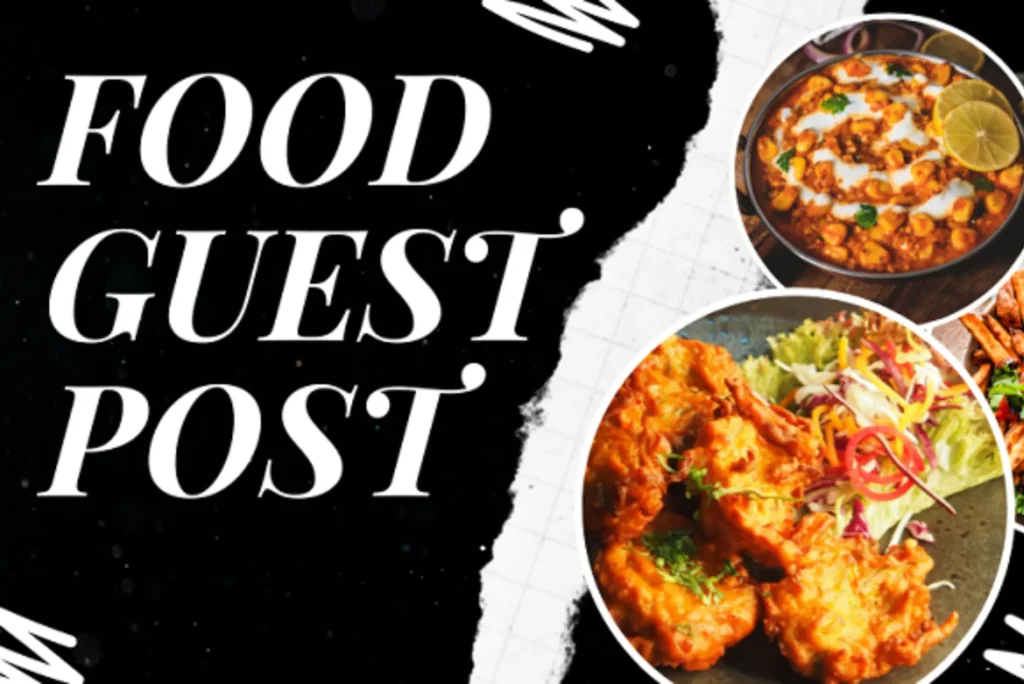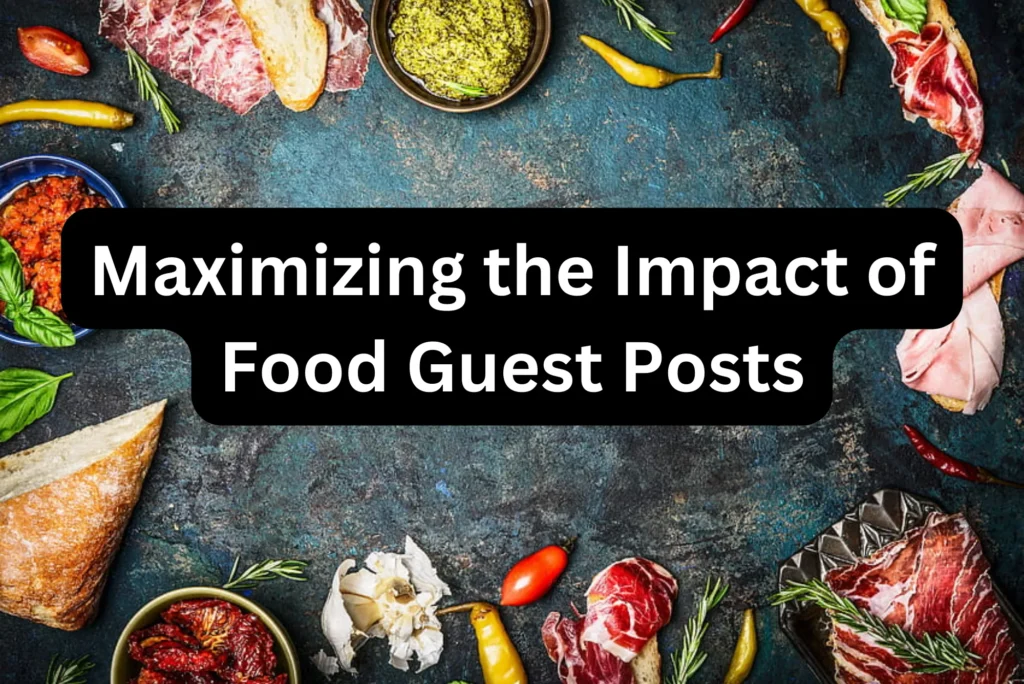In today’s digital age, where culinary enthusiasts abound, food guest posting has emerged as a powerful tool for sharing expertise, reaching new audiences, and building authority in the food industry. Understanding the intricacies of food guest posting, from crafting compelling content to adhering to platform guidelines, can significantly enhance your visibility and influence within the culinary community. This comprehensive guide delves into the nuances of food guest posting, offering insights, tips, and strategies to help you maximize your impact in this dynamic realm.
Understanding Food Guest Posting
What is Food Guest Posting?
Food guest posting is a strategic marketing approach wherein individuals or businesses contribute content to other platforms within the food niche as guest authors. These platforms could include food blogs, recipe websites, culinary magazines, social media accounts, or online communities dedicated to food and cooking. The essence of food guest posting lies in collaboration and mutual benefit: guest authors gain exposure, credibility, and backlinks, while host platforms receive fresh content, increased engagement, and diverse perspectives.
Guest posts within the food niche can take various forms, including recipes, cooking tutorials, kitchen tips, restaurant reviews, food photography showcases, culinary travelogues, and industry insights. The key is to offer valuable and relevant content that resonates with the host platform’s audience while showcasing the expertise and unique voice of the guest author.
How Food Guest Posting Works
The process of food guest posting typically involves several stages, starting with research and outreach and culminating in publication and promotion:
- Research: Guest authors begin by researching potential host platforms within the food niche that align with their target audience, content focus, and niche expertise. This may involve browsing through food blogs, following social media accounts, and engaging with online communities to identify suitable opportunities for guest posting.
- Outreach or Pitching: Once potential host platforms have been identified, guest authors may reach out to the platform’s editorial team or submit pitches outlining their proposed guest post ideas. It’s essential to tailor pitches to each platform, demonstrating an understanding of their audience, content style, and editorial guidelines.
- Content Creation: Upon acceptance of a pitch or submission of a guest post proposal, guest authors proceed to create high-quality content that meets the platform’s content standards and audience expectations. This may involve conducting research, writing engaging copy, sourcing images or videos, and adhering to any specific formatting or style guidelines provided by the platform.
- Submission and Review: The completed guest post is submitted to the host platform for review by the editorial team. Editors may provide feedback or revisions to ensure the content meets their publication standards and aligns with the platform’s brand voice and audience preferences.
- Publication: Once the guest post meets the platform’s approval, it is published on the platform’s website, blog, or social media channels. Guest authors may receive attribution in the form of a byline, author bio, or social media mention, along with a link back to their own website or social profiles for increased visibility and traffic.
- Promotion: After publication, guest authors are encouraged to promote their guest posts through their own channels, including social media, email newsletters, and personal blogs. Engaging with readers, responding to comments, and sharing the post with their network can help amplify the reach and impact of the guest post.
Writing Food Guest Posts

Crafting compelling content is essential to captivate readers and maximize the impact of your food guest posts. Whether you’re sharing mouth-watering recipes, culinary insights, or restaurant reviews, mastering the art of effective writing can elevate your guest posts to new heights of engagement and influence. Here are some additional insights and tips to enhance your writing for food guest posts:
Researching Trending Topics
Stay abreast of current culinary trends, emerging ingredients, and popular cooking techniques to ensure that your content remains relevant and engaging. Research trending topics within your niche and explore unique angles or perspectives to differentiate your guest posts from existing content. By addressing timely subjects that resonate with readers, you can attract more attention and generate meaningful discussions around your posts.
Tailoring Content to Audience Preferences
Understand the preferences, interests, and demographics of the target audience on the host platform. Tailor your content to meet their needs and expectations, whether they’re novice home cooks, gourmet foodies, or health-conscious consumers. Consider the platform’s tone, style, and content format when crafting your guest posts to ensure alignment with audience preferences and maximize engagement.
Incorporating Visual Elements
Enhance the visual appeal of your food guest posts by incorporating high-quality images, videos, and infographics. Visual elements not only complement your written content but also provide visual cues and inspiration for readers. Use mouth-watering food photography, step-by-step recipe videos, and informative infographics to enhance the reader experience and make your content more shareable and memorable.
Storytelling and Personalization
Infuse your food guest posts with storytelling elements and personal anecdotes to create a deeper connection with readers. Share your passion for food, culinary adventures, and memorable cooking experiences to engage readers on an emotional level. Whether it’s recounting a childhood recipe passed down through generations or sharing the inspiration behind a creative dish, storytelling adds authenticity and personality to your guest posts, making them more relatable and memorable.
Creating Engaging Headlines and Introductions
Capture readers’ attention from the outset with compelling headlines and introductions that pique curiosity and entice them to continue reading. Craft attention-grabbing headlines that highlight the value proposition of your guest post and spark interest in exploring further. Follow up with captivating introductions that set the tone, establish relevance, and promise a rewarding reading experience, encouraging readers to delve deeper into your content.
Providing Practical Tips and Takeaways
Offer practical tips, actionable advice, and useful takeaways that empower readers to apply your insights in their own culinary endeavors. Whether it’s sharing time-saving cooking hacks, ingredient substitution suggestions, or flavor pairing recommendations, provide valuable information that enhances readers’ skills and knowledge. By offering tangible benefits and solutions, you establish credibility and authority as a trusted resource in the food community, fostering reader loyalty and engagement.
Engaging with Readers and Encouraging Interaction
Encourage reader interaction and feedback by inviting comments, questions, and suggestions at the end of your guest posts. Engage with readers by responding promptly to comments, addressing inquiries, and fostering meaningful discussions around your content. Actively participate in community conversations on the host platform, sharing insights, providing assistance, and building connections with fellow food enthusiasts. By fostering a sense of community and dialogue, you create a more enriching and interactive experience for readers, enhancing the impact of your food guest posts.
Tips for Effective Food Guest Post Writing
- Know Your Audience: Tailor your content to the preferences and interests of the host platform’s audience.
- Be Authentic: Share personal anecdotes, experiences, and insights to establish credibility and connect with readers.
- Optimize for SEO: Incorporate relevant keywords, meta descriptions, and tags to improve search engine visibility and ranking.
- Follow Guidelines: Adhere to the platform’s editorial guidelines, formatting requirements, and word count limits to ensure smooth publication.
Guidelines for Submitting Food Guest Posts
Submitting food guest posts requires careful attention to platform-specific guidelines, content requirements, and formatting standards to ensure acceptance and successful publication. By following these guidelines meticulously, you can increase your chances of securing guest post opportunities and effectively engaging with your target audience.
Platform-Specific Guidelines
Before submitting your food guest post, thoroughly review the submission guidelines provided by the host platform. These guidelines typically outline the platform’s preferences, requirements, and expectations for guest contributions. Pay close attention to instructions regarding:
- Pitching Process: Some platforms require authors to pitch their ideas before submitting full articles. Craft a concise and compelling pitch that highlights the relevance, uniqueness, and potential value of your proposed topic.
- Content Focus: Understand the platform’s content focus and audience demographics to ensure that your guest post aligns with their interests and preferences. Tailor your content to fit within the platform’s niche while offering a fresh perspective or unique angle.
- Tone and Style: Familiarize yourself with the platform’s tone, style, and editorial standards by reading existing content. Match your writing style, voice, and tone to maintain consistency and coherence with the platform’s overall brand and messaging.
- Author Bio and Links: Include a brief author bio that highlights your expertise, credentials, and relevant affiliations. Provide links to your website, blog, social media profiles, or other online platforms to facilitate reader engagement and establish credibility.
Content Requirements
When crafting your food guest post, focus on providing valuable, informative, and engaging content that adds value to the platform and resonates with its audience. Consider the following content requirements:
- Originality: Ensure that your content is original, well-researched, and free of plagiarism. Offer fresh insights, personal experiences, or expert advice to distinguish your guest post from existing content on the platform.
- Relevance: Address topics, trends, or issues that are timely, relevant, and of interest to the platform’s audience. Consider current events, seasonal themes, or emerging trends in the food industry to capture readers’ attention and stimulate discussion.
- Quality: Maintain high standards of quality in writing, presentation, and content depth. Provide accurate information, cite credible sources, and support your arguments with evidence, examples, or anecdotes to enhance credibility and reader trust.
- Value Proposition: Clearly articulate the value proposition of your guest post, highlighting the benefits, insights, or takeaways that readers can expect to gain from reading your content. Focus on solving problems, answering questions, or fulfilling needs within the target audience.
Formatting and Style Guidelines
Adhere to the platform’s formatting and style guidelines to ensure consistency, readability, and professionalism in your food guest post. Follow these formatting and style guidelines:
- Headings and Subheadings: Use clear, descriptive headings and subheadings to organize your content and guide readers through the article. Incorporate keywords or phrases to improve SEO and facilitate content navigation.
- Paragraph Structure: Break up your content into short paragraphs for easy readability. Use transition words and phrases to maintain coherence and flow between paragraphs.
- Visual Elements: Incorporate relevant images, videos, infographics, or other visual elements to enhance the visual appeal and engagement of your guest post. Ensure that visual assets are high-quality, properly formatted, and align with the content.
- Language and Tone: Write in a clear, concise, and engaging manner that resonates with the platform’s audience. Use language that is accessible, jargon-free, and tailored to the reader’s level of expertise or interest in the topic.
Maximizing the Impact of Food Guest Posts

Promoting Your Guest Posts
After your food guest post is published, leverage your own channels and networks to promote it to a wider audience. Share the post on your social media profiles, website, email newsletter, and other relevant platforms. Engage with readers by responding to comments, answering questions, and encouraging discussion around the content.
Building Relationships with Host Platforms
Invest time and effort into building mutually beneficial relationships with host platforms and their editorial teams. Stay engaged with the platform by contributing regularly, providing valuable feedback, and participating in community discussions. Establishing a positive rapport can increase your chances of future guest post opportunities and collaborations.
Measuring Success and Adjusting Strategies
Track the performance of your food guest posts by monitoring metrics such as website traffic, social media engagement, backlinks, and reader feedback. Analyze which topics, formats, and platforms resonate most with your audience and adjust your guest posting strategies accordingly. Continuously refine your approach based on data-driven insights to optimize your impact over time.
Common Mistakes to Avoid in Food Guest Posting
Food guest posting can be a powerful tool for expanding your reach, establishing authority, and building connections within the culinary community. However, certain pitfalls can hinder your success if not addressed effectively. By being aware of common mistakes and taking proactive steps to avoid them, you can maximize the impact of your guest posting efforts and achieve your desired goals.
Lack of Research
One of the most common mistakes in food guest posting is failing to conduct thorough research before pitching ideas or submitting content. Without a solid understanding of the target platform, its audience demographics, content preferences, and editorial guidelines, your efforts may fall flat. Take the time to familiarize yourself with the platform’s existing content, tone, and style to ensure that your pitches and submissions align with their expectations. Research trending topics, popular keywords, and audience interests to craft content that resonates with readers and adds value to the platform’s offerings.
Overly Promotional Content
Another common pitfall is creating content that comes across as overly promotional or self-serving. While it’s natural to want to promote your brand, products, or services, overtly promotional content can turn off readers and undermine your credibility. Instead, focus on providing valuable insights, practical tips, and engaging storytelling that enriches the reader experience and positions you as a trusted authority in the food industry. Strike a balance between showcasing your expertise and offering genuine value to readers, avoiding blatant sales pitches or thinly veiled advertisements.
Ignoring Platform Guidelines
Ignoring or disregarding the platform’s submission guidelines, formatting requirements, and editorial standards is a recipe for rejection and frustration. Each platform has its own set of rules and preferences regarding guest contributions, ranging from word count limits and formatting styles to content themes and quality standards. Before pitching ideas or submitting content, carefully review the platform’s guidelines to ensure that your submissions meet their criteria. Pay attention to details such as preferred file formats, image specifications, attribution requirements, and any specific instructions for author bios or links. By adhering to the platform’s guidelines, you demonstrate professionalism, respect for their editorial process, and a willingness to collaborate effectively.
Lack of Engagement and Follow-up
A common mistake that many guest contributors make is submitting their content and then disengaging from the process entirely. While getting your guest post published is an important milestone, it’s just the beginning of your engagement with the platform and its audience. Take proactive steps to promote your guest post across your own channels and networks, driving traffic back to the platform and increasing visibility for your content. Engage with readers by responding to comments, answering questions, and participating in discussions around your post. Building rapport with the platform’s audience can lead to valuable connections, opportunities for collaboration, and increased exposure for your brand or business.
Case Studies and Examples
Successful Food Guest Post Examples
- Recipe Roundup: A curated collection of quick and easy weeknight dinner recipes published on a popular food blog garnered thousands of views and shares, driving traffic back to the author’s cooking website.
- Ingredient Spotlight: An in-depth exploration of the health benefits and culinary uses of a trendy superfood featured on a nutrition-focused website received rave reviews and sparked lively discussions among readers.
Lessons Learned from Failed Attempts
- Pitch Rejection: A poorly researched pitch that did not align with the platform’s content focus and audience interests resulted in rejection from the editorial team.
- Low Engagement: An overly promotional guest post that lacked substantive content failed to resonate with readers, resulting in minimal engagement and shares.
| Case Study | Description |
|---|---|
| Successful Food Guest Post Examples | |
| Recipe Roundup | A curated collection of quick and easy weeknight dinner recipes published on a popular food blog garnered thousands of views and shares, driving traffic back to the author’s cooking website. |
| Ingredient Spotlight | An in-depth exploration of the health benefits and culinary uses of a trendy superfood featured on a nutrition-focused website received rave reviews and sparked lively discussions among readers. |
| Lessons Learned from Failed Attempts | |
| Pitch Rejection | A poorly researched pitch that did not align with the platform’s content focus and audience interests resulted in rejection from the editorial team. |
| Low Engagement | An overly promotional guest post that lacked substantive content failed to resonate with readers, resulting in minimal engagement and shares. |







